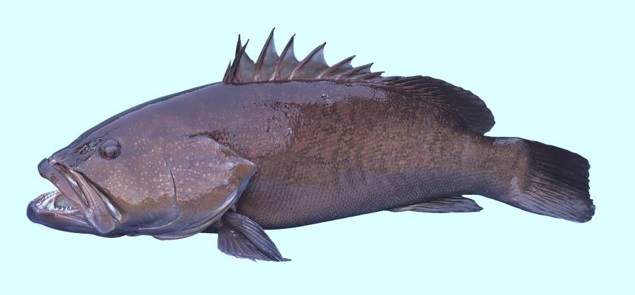
水試所海水養殖研究中心已成功的繁殖出耐低溫之褐石斑魚 (俗稱油斑,Epinephelus brunneus)。經過 4年的繁養殖試驗,成功培育的褐石斑魚白身苗達12,000尾,育成率約8%。相關繁養殖技術可傳授養殖業者以期減低寒害對於石斑魚產業造成的損失。同時,亦可增加養殖種類、面積與產量,以達產業永續發展之目標。
褐石斑為溫帶海水魚類,肉質細嫩、鮮美並帶有適度油質,為生魚片及海鮮火鍋的頂級食材,價格昂貴。棲息於礁岩及泥底質水域,主要分布於日本、韓國、中國沿岸至香港和臺灣海域,近年來因過度捕撈致使產量大不如前。
由於褐石斑為溫帶魚類,其養殖適溫為 20-28℃,耐受水溫 10-32℃,13-14℃之低水溫仍會攝食,相較於點帶石斑魚 (耐受水溫 13-35℃)、鞍帶石斑魚 (耐受水溫 14-35℃)、棕點石斑魚 (耐受水溫 16-35℃),更能適應臺灣冬季之低水溫期。
褐石斑繁殖技術的成功是石斑魚產業一項新的研發成果,養殖推廣成功後,將可降低冬季或氣候變遷帶來的寒害對石斑魚養殖產業的衝擊。

圖. 水試所海水養殖研究中心已成功的繁殖出耐低溫之褐石斑魚
The Mariculture Research Center of the Fisheries Research Institute has successfully bred the kelp grouper (Epinephelus brunneus). After four years of breeding and culture trials, the Center successfully produced 12,000 juvenile kelp groupers with a survival rate of approximately 8%. The developed breeding techniques can be transferred to aquaculture farmers to help reduce the economic losses caused by cold damage in the grouper industry. In addition, this success will contribute to diversifying cultured species, expanding farming areas, and increasing production, thereby promoting the sustainable development of the aquaculture industry.
The kelp grouper is a temperate marine species with delicate, flavorful flesh and moderate oil content, making it a premium ingredient for sashimi and seafood hotpot. It inhabits rocky reefs and muddy bottoms and is mainly distributed along the coasts of Japan, Korea, China, Hong Kong, and Taiwan. However, in recent years, overfishing has led to a significant decline in its natural populations.
As a temperate species, the kelp grouper grows best at temperatures between 20 and 28°C and can tolerate a range of 10–32°C. It continues to feed even at 13–14°C, showing better cold tolerance than other commonly farmed groupers such as the orange-spotted grouper (E. coioides, 13–35°C), the giant grouper (E. lanceolatus, 14–35°C), and the brown-marbled grouper (E. fuscoguttatus, 16–35°C). This makes it particularly suitable for aquaculture during the low-temperature periods of Taiwan's winter season.
The successful development of artificial breeding techniques for E. brunneus represents an important breakthrough for the grouper industry. Once large-scale culture is promoted, it is expected to mitigate the impact of cold damage and climate change on grouper aquaculture production.
禁止未經授權之複製或下載等用於營利行為,違者依法必究。 農業部 版權所有 © 2025 All Rights Reserved.
維護單位: 水產試驗所 最佳瀏覽狀態為 IE7.0 以上, 1024*768 解析度